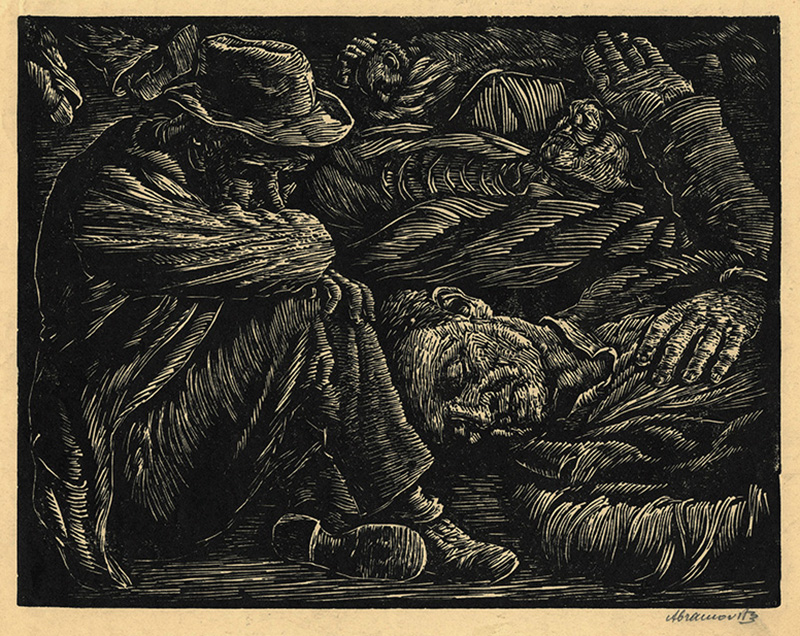Flop House is a linoleum cut created in 1932 by Latvian born, American printmaker Albert Abramovitz. It is pencil signed in the lower right and was printed by the artist on cream wove Rolland Parchment paper. The edition thought to be around 25 impressions the image measures 8-1/2 x 11 inches. This linocut was produced during the WPA period but is not listed in the GSA book WPA Artwork in Non-Federal Repositories.
Flop House is a gripping example of Abramovitz's use of social commentary in his imagery, It was created in 1932, the year that the unemployment rate peaked at 26.3% during the early part of the Great Depression. Packed into a cramped composition, homeless, out of work men sleep "flopped" on the floor of a cheap lodging house so tightly packed together that some men have to sleep sitting up with their hats on. The services of this flophouse are so minimal that the men were not given the comforts of blankets or mattresses. In 1933, newly elected President Franklin Delano Roosevelt initiated the first "New Deal" to put Americans back to work, employing eight million workers over the next several years. They worked building roads, bridges, airports and infrastructure for the United States. In June of 1934, Roosevelt signed into law the National Housing Act and the Federal Housing Administration to improve housing conditions.
Albert Abramovitz, painter and printmaker, was born in Riga, Latvia, on January 24, 1879. He studied art at the Imperial Art School in Odessa and, in Paris, at the Académie de la Grande Chaumière. While in Paris, he became a member of the Salon in 1911, and he served on its jury in 1913. Abramovitz also became a member of the Societaire Salon d'Automne. While in Europe he received a medal at Clichy, as well as the Grand Prize at the Universal Exposition in Rome and Turin, Italy in 1911.
In 1916, Abramovitz immigrated to the United States. His first solo show was at the Civic Club in Manhattan in 1921. Between 1927 and 1929, he was a resident of Los Angeles, California, but by the mid to late 1930s he had settled in Brooklyn, New York. His graphic work was included in both the 1938 and the 1939 International Exhibition of Lithographs and Wood Engraving at the Art Institute of Chicago. In 1940, a solo exhibition of his work was mounted at the Bonestell Gallery and Abramovitz was included in exhibitions sponsored by the Union of American Artists, the American Artists Congress, the ACA Gallery, the New-Age Gallery, the National Academy of Design, and the American Association of University Women.
In his graphics and paintings, Abramovitz’s imagery often focused upon social or political commentary. He produced a number of prints for the Federal Arts Project Works Progress Administration in New York between 1935 and 1939. His works are in the collections of the Crystal Bridges Museum of American Art, Bentonville, Arkansas; the Amon Carter Museum of American Art, Fort Worth, Texas; the Washington County Museum of Fine Arts, Hagerstown, Maryland; the Spencer Museum of Art, Lawrence, Kansas; the British Museum and the Victoria and Albert Museum, London; the Frederick R. Weisman Art Museum at the University of Minnesota, Minneapolis; the David Owsley Museum of Art at Ball State University, Muncie; the Newark Museum, New Jersey; the Jewish Museum, the Metropolitan Museum of Art, and the New York Public Library, New York; the Philadelphia Museum of Art, Pennsylvania; and the Library of Congress and the Smithsonian American Art Museum, Washington, D.C.
Albert Abramovitz died on 13 July 1963 in East Meadow, Long Island, New York.



